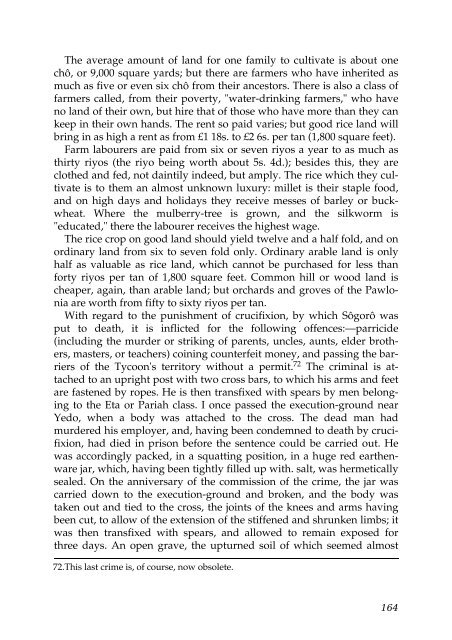You also want an ePaper? Increase the reach of your titles
YUMPU automatically turns print PDFs into web optimized ePapers that Google loves.
The average amount <strong>of</strong> land for one family to cultivate is about one<br />
chô, or 9,000 square yards; but there are farmers who have inherited as<br />
much as five or even six chô from their ancestors. There is also a class <strong>of</strong><br />
farmers called, from their poverty, "water-drinking farmers," who have<br />
no land <strong>of</strong> their own, but hire that <strong>of</strong> those who have more than they can<br />
keep in their own hands. The rent so paid varies; but good rice land will<br />
bring in as high a rent as from £1 18s. to £2 6s. per tan (1,800 square feet).<br />
Farm labourers are paid from six or seven riyos a year to as much as<br />
thirty riyos (the riyo being worth about 5s. 4d.); besides this, they are<br />
clothed and fed, not daintily indeed, but amply. The rice which they cultivate<br />
is to them an almost unknown luxury: millet is their staple food,<br />
and on high days and holidays they receive messes <strong>of</strong> barley or buckwheat.<br />
Where the mulberry-tree is grown, and the silkworm is<br />
"educated," there the labourer receives the highest wage.<br />
The rice crop on good land should yield twelve and a half fold, and on<br />
ordinary land from six to seven fold only. Ordinary arable land is only<br />
half as valuable as rice land, which cannot be purchased for less than<br />
forty riyos per tan <strong>of</strong> 1,800 square feet. Common hill or wood land is<br />
cheaper, again, than arable land; but orchards and groves <strong>of</strong> the Pawlonia<br />
are worth from fifty to sixty riyos per tan.<br />
With regard to the punishment <strong>of</strong> crucifixion, by which Sôgorô was<br />
put to death, it is inflicted for the following <strong>of</strong>fences:—parricide<br />
(including the murder or striking <strong>of</strong> parents, uncles, aunts, elder brothers,<br />
masters, or teachers) coining counterfeit money, and passing the barriers<br />
<strong>of</strong> the Tycoon's territory without a permit. 72 The criminal is attached<br />
to an upright post with two cross bars, to which his arms and feet<br />
are fastened by ropes. He is then transfixed with spears by men belonging<br />
to the Eta or Pariah class. I once passed the execution-ground near<br />
Yedo, when a body was attached to the cross. The dead man had<br />
murdered his employer, and, having been condemned to death by crucifixion,<br />
had died in prison before the sentence could be carried out. He<br />
was accordingly packed, in a squatting position, in a huge red earthenware<br />
jar, which, having been tightly filled up with. salt, was hermetically<br />
sealed. On the anniversary <strong>of</strong> the commission <strong>of</strong> the crime, the jar was<br />
carried down to the execution-ground and broken, and the body was<br />
taken out and tied to the cross, the joints <strong>of</strong> the knees and arms having<br />
been cut, to allow <strong>of</strong> the extension <strong>of</strong> the stiffened and shrunken limbs; it<br />
was then transfixed with spears, and allowed to remain exposed for<br />
three days. An open grave, the upturned soil <strong>of</strong> which seemed almost<br />
72.This last crime is, <strong>of</strong> course, now obsolete.<br />
164



